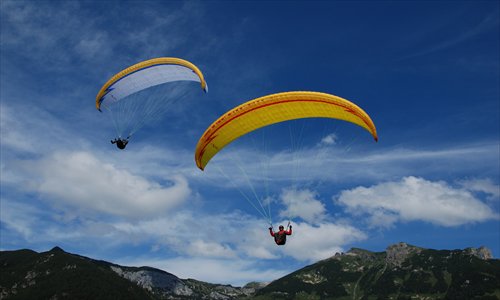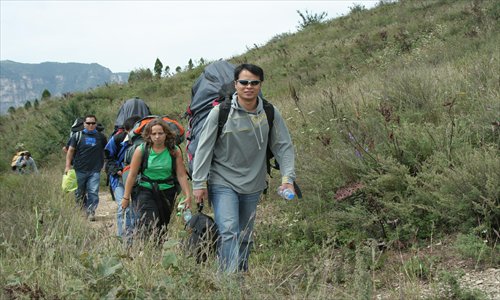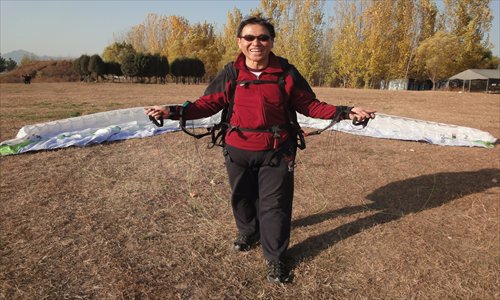Paragliding to new heights

Paragliding instructor Yan Qinglin enjoys a bird's-eye view of a sunset in January 2010 near Mangshan Mountain, Changping district. Photo: Courtesy of Yan Qinglin
Situated 40 kilometers northeast of downtown Beijing in Changping district, Mangshan Mountain is a hub for nature lovers and tourists. At this time of the year, it is common to see hordes of mountain climbers snaking their way up its trail to the summit. But if you cast your eye skyward, you're likely to find a group of daredevils who use the mountain as a launch pad for their high-adrenaline hobby.
Drawn by clear weather and a steady breeze, paragliders normally dot the smog-free skies over Mangshan Mountain in early winter. But on Thursday, paragliders' feet were firmly grounded between the mountain and nearby Ming Tombs Reservoir, where a group of five novices was learning basic maneuvers under the watchful eye of instructor Yan Qinglin.
"Paragliding is temporarily banned at many locations [in Beijing], so we can only do training on the ground today. The ban won't last long. Every time there is an important meeting in Beijing, all aerial sports are suspended," said Yan, a paragliding instructor with Beijing Flying-man Sports.

Paragliding instructor Yan Qinglin glides from Mangshan Mountain.Photo: Courtesy of Yan Qinglin

Yan leads members of the Beijing Flying-man Sports up Mangshan Mountain. Photo:Courtesy of Yan Qinglin
Risks and rewards
Yan said the best period for paragliding in Beijing is between September and October, but unusually mild temperatures this winter have extended the sport's season. In any case, conditions have to be just right before paragliders can take to the skies.
"The wind should not be too weak or strong, otherwise it is difficult to control the parasail. We have had to rescue paragliders in the past who have become stuck in trees due to their improper operation of the parasail in strong winds. Such rescues are difficult and accidents can potentially be life-threatening," said Yan.
The popularity of paragliding took off during the 1970s in Europe. One of the most notable early flights was by French mountain climber Jean-Claude Bétemps, who managed to glide down a mountain in the Alps using a square parachute in 1978.
In China, the sport has a much shorter history punctuated by rapid development in recent years.
Beijing Flying-man Sports' training bases are located at the foot and summit of Mangshan Mountain. The club has more than 100 paragliders, whose ages range from 20 to over 70.
As far as extreme sports go, Yan said paragliding is relatively safe. However, he stressed it demands professionalism in mastering varying wind speeds and navigation.
Yan, who started paragliding in 2004, has participated in many Chinese and international aerial sport competitions. Throughout his decade of paragliding, he has had many dangerous and breathtaking experiences. He once soared among the clouds at an altitude of more than 4,000 meters in a competition in Henan Province. Another time he became distracted while gliding in rough weather and crashed into Mangshan Mountain. The accident left him severely injured and bed-ridden for several months.
Safety is one of the biggest concerns associated with paragliding in China. In 2007, former paragliding national team member He Zhongpin died after he was sucked into a storm system while flying at 5,900 meters. Tragedy rocked the sport most recently last month, when an uncertified paragliding instructor in Mianzhu, Sichuan Province, fell from his parasail and died during an October 6 flight with a 12-year-old boy, who survived after landing in a tree.

Xi Junwu, a novice paraglider who has taken time off work to dedicate himself to the sport. Photo:Li Lin/GT
'Bird people' spread wings
Die-hard paragliders aren't deterred from their hobby despite the risks they face each time they step into the parasail harness. Zou Ying, a 35-year-old female paraglider, said she was immediately bitten by the "paragliding bug" when she took up the sport in 2008.
"I only had five lessons before my first flight, but was quite familiar with everything. We call ourselves 'bird people' because we are able to fly," she said.
Zou, who last year moved from Beijing to Guangzhou, Guangdong Province, ensured she continued paragliding with new friends to get her adrenaline fix.
"Life as a housewife is too boring ordinarily with little excitement," said Zou, "Paragliding has become my new lifelong 'career.' I won't give it up until I am too old. Once you experience the fun of paragliding, you never quit."
Xi Junwu, a former senior manager at a Fortune 500 company, is one of Yan's new students eager to experience the rush of paragliding. "Flying has long been man's dream as well as my personal dream since I was a little boy. Paragliding has given me the chance to realize this dream," said Xi.
"I once watched a paragliding competition at the Alps and was awe-struck. People flew freely in colorful parasails against the backdrop of blue sky, white snow and towering mountains. It was so beautiful."
After only three lessons on the ground, Xi said he had already fallen in love with paragliding.
He requested long-term leave from his company to devote himself to paragliding, a move he downplayed by recalling how one man even sold his company to focus on paragliding full time.
"Today, you can see my students are learning the basics on the ground before they can be deemed qualified to fly. All of them are novices, but they will be ready to take to the skies once the ban is lifted," said Yan.
"Our paragliders usually take off from near the top of Mangshan Mountain, which is 659 meters above the sea level. We usually take off from a height of 530 meters, but we can rise to about 900 meters."
Although softly spoken when explaining his passion for paragliding, Yan is quick to raise his voice if he sees one of his students putting their safety at stake.
"Hey! Check out your left wingtip! It is still rolled up! If you're unwilling to spare a few minutes unfolding the whole parasail, imagine what will happen to you in mid-air," shouted Yan at one of his students.
"Always mind your center of gravity! Don't brake too hard!" Yan barked, gradually lowering his tone.
"I have to be very strict with them during lessons on the ground. If I lower my criteria judging who is ready to fly, accidents are likely to happen."
Learning to fly
During my interview with Yan, he encouraged me to lace up a harness and get a feel of the paragliding, albeit from the ground. Strapping on a parasail felt like carrying a large backpack with many straps connected to a huge parachute.
Once a harness was adjusted around my waist and legs, there was only one thing left to do. "Run!" Yan yelled at the top of his voice, grabbing a shoulder and arm to help maintain balance. After running a few paces, the huge parachute opened and rose in the sky, making a tremendous noise. At the same time the straps connecting the parachute and backpack instantly tightened.
As an overwhelming force pulled me backwards and up, it became difficult to maintain my balance.
"Lower your center of gravity and put your arms backwards! Don't brake too hard! Stand stable!" Yan shouted. With the veteran paraglider's help, I gradually managed to stop swaying side to side and "flew" about half a meter into the air. The experience? Imagine being dragged up by huge wings on your back.
Paragliding is an international sport in Beijing, Yan said. "We have members [at the Beijing Flying-man Sports] from all over the world, including Turkey, Russia and US," he said. "We used to have foreign instructors who were very experienced and professional, but now they have all left."
Yan said the club hopes that by participating in international competitions, such as the recently concluded 2nd Beijing International Aviation Sports Invitational (BIASI), paragliding can be popularized in Beijing.
"I am very glad to see a boost of aerial sport development in China," said Yan.
"We had many foreign competitors from Austria, Hungary, Germany, Bulgaria, France, New Zealand, the Czech Republic and Spain [at the BIASI]. There were also pilots performing aerial stunts from Britain, Finland, Romania and Hungary."
During the competition, paragliders flew over the Jiayuguan section of the Great Wall in Gansu Province, which Yan described as a "really amazing" experience.
"However, no matter how beautiful the scenery is that you see and no matter how excited you are when paragliding, you must focus on your operation. Of course, you must pass an examination to get a flying license issued by the China Aviation Transportation Association, pass a health examination and take out an insurance policy before you start paragliding," he said.
For new starters and people interested in paragliding, Yan said the most important thing during entertainment in the sky is to maintain safety, and come back to the ground with no hurts.
"I have to especially mention one thing," said Yan while adjusting a student's parasail, "You must ensure good maintenance not only to your main parasail but the emergency one, too. It is only used when the major parasail fails to operate, so there is only one chance to save your life in an accident."
According to Yan, the backup parasail should be unfolded outdoors to rid condensation at least once every six months.